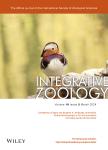Mammal diversity during the Pleistocene-Holocene transition in Eastern Europe
作者机构:Institute of GeographyRussian Academy of SciencesMoscowRussia
出 版 物:《Integrative Zoology》 (整合动物学(英文版))
年 卷 期:2014年第9卷第4期
页 面:461-470页
核心收录:
学科分类:0710[理学-生物学] 070903[理学-古生物学与地层学(含:古人类学)] 0709[理学-地质学] 07[理学] 0905[农学-畜牧学] 0906[农学-兽医学]
主 题:Eastern Europe Holocene climatic optimum mammal diversity Pleistocene-Holocene transition Pleistocene Last Glacial Maximum
摘 要:Fossil record data on the mammal diversity and species richness are of importance for the reconstruction of the evolution of terrestrial ecosystems during the Late Pleistocene-Holocene *** Eastern Europe,the transformations during the Pleistocene-Holocene transition consisted mainly in changes in zonal structure and local fauna composition(Markova&Kolfschoten 2008).We investigated the species richness and the analogues of theα,βdiversity indexes(in the sense of Whittaker 1972)of large and medium size mammals for 13 climate-stratigraphic units dating to the Late Pleistocene and the Holocene,from the Hasselo Stadial(44-39 kBP)to the Subatlantic period and the present *** biological diversity of the Last Glacial Maximum(LGM)and the Holocene thermal optimum was investigated in more detail using information about all mammalian taxa(PALEOFAUNA database;Markova 1995).One of our results show that theα,βdiversity values show only a negative correlation with the temperature conditions during the Late Pleistocene,the period that is characterized by the so-called‘Mammoth Fauna’*** the Holocene faunas the diversity indexes are nearly independent from physical conditions;theαdiversity index decreased and theβdiversity index *** relatively lowαdiversity and highβdiversity indexes for the present-day faunas are referred to the decrease of the population number of some forest species in historical time and the increase of the dominance of unspecialized species or the species connected with intra-zonal *** study shows furthermore the occurrence of several East European‘centers’with a high mammal diversity,which are relatively stable during the Pleistocene-Holocene *** orientation of the boundaries between the large geographical mammal assemblages depended,particularly in the northwestern part of Eastern Europe,on the expansion of the Scandinavian ice sheet.



